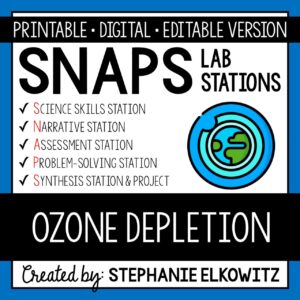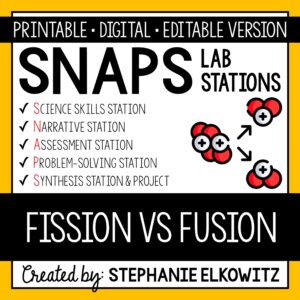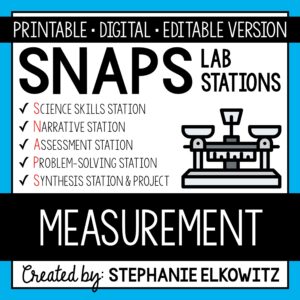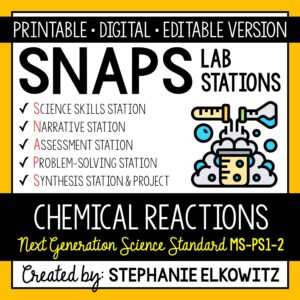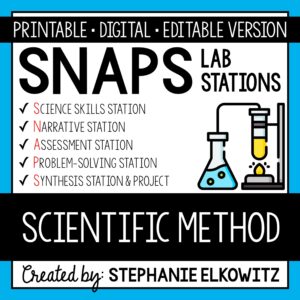4-PS3-4 Energy Transformation Lab
$7.00
An engaging lab activity designed to enhance students’ understanding of energy transformation. Aligned with NGSS 4-PS3-4.
Description
4-PS3-4 Energy Transformation Lab Preview
SNAPs Lab Stations Activities require students to use science, math, literacy, problem-solving and engineering skills. They are designed to enhance students’ understanding of scientific concepts and help students apply scientific ideas to the real world. Each station activity promotes skills so to develop students into proficient and competent scientific thinkers.
SNAPs lab activities have five components:
• Science Skills Station to develop science skill proficiency
• Narrative Station to build science literacy
• Assessment Station to evaluate learning and understanding
• Problem-Solving Station to foster engineering design
• Synthesis Station and Project to inspire higher-order learning
DIGITAL LABORATORY – DISTANCE LEARNING & DIGITAL CLASSROOMS
• This lab is offered in a digital format to support digital classrooms & distance learning.
• The digital lab activity is designed to work with Google Slides and Microsoft PowerPoint
• The digital lab activity CANNOT be edited. However:
– Students can manipulate text boxes
– Students can create tables, graphs and diagrams
– Students can insert images and drawings
GOOGLE FORM ASSESSMENT STATION
• The assessment station is offered as a self-grading Google Form.
• Questions are all short answer and are 100% editable.
• Suggestions for use are included in the download.
DISTANCE LEARNING COMPATIBILITY
SNAPs lab activities are rated for their ease with distance – independent learning. Refer to the preview for more information about how well this laboratory works in a fully digital classroom and with distance learning.
EDITABLE DOCUMENTS
This download includes an editable word document (docx file) of all lab components:
• Pre-Lab and Post-Lab Activities
• The Lab Overview
• Lab Station Activities and Questions
• Directed Synthesis Project (when applicable)
Important Notes:
• Diagrams, illustrations, tables and graphs essential to lab activities are included
• Illustrative clipart is NOT included
• Editable documents and rubrics are included with the FREE SNAPs Setup Guide
Editable files allow you to:
• Edit the scope of the activities so to suit your students’ needs
• Edit the materials required based on resource availability
• Create single-period “mini-labs” using activities at the individual skills stations
The activities at each station in this lab are detailed below.
Energy Transformation Lab Learning Objectives
1. Discuss energy transformation.
2. Make observations and explain how energy transforms from one form to another in different scenarios.
3. Build, test and improve a device that converts one form of energy into another.
Science Skills Station
Students will make observations to study energy transformation. Students will observe different scenarios and describe the transformation of energy that is occurring in each scenario.
Narrative Station
Students will read a passage about energy transformation. Students will also watch a video about energy transformation.
Assessment Station
At this station, students will answer questions about key terms and ideas about energy transformation. Students must employ lower, mid and higher order thinking skills to answer these questions.
Problem-Solving Station
Students will build a passive solar oven at this station. Students will follow a general plan to build the oven. Students will have opportunities to alter the design of the oven to maximize its use.
Synthesis Station
Students will compose a CER (claim-evidence-reasoning) report to summarize the lab. Students are provided the claim statement and must support the claim with observations, data and other information gathered in the lab. Students will explain how the evidence supports the claim using scientific reasoning.
Synthesis Project
Students will have a choice of 11 projects. Refer to the SNAPs Lab Stations Best Practices and Setup Guide for directions and suggestions on how to conduct the project.
Directed Synthesis Project
Students can conduct one of the 11 standard synthesis projects, but I strongly suggest using the directed synthesis project to best summarize the information in this lab. With this project, students will design, build and test a toy car with a DC motor and electric circuit. The car must travel five feet in a relatively straight line to be considered successful. Students will be constrained in time and resources.
This download includes:
• A pre-lab assignment and post-lab reflection
• Directions and questions for each lab station
• Student recording sheets
• Teacher Key
Additional Materials Required:
1 Computer or tablet
1 Basketball
1 Blow dryer
1 Fan
1 Flashlight (with batteries)
1 Tambourine
1 Pizza box (per group)
Various colored construction paper
Newspaper
Saran wrap
Wax paper (letter-sized pieces)
Felt (letter-sized pieces)
Tape and scissors
Graham crackers, chocolate bars and marshmallows
If performing the directed synthesis project in class you will also need:
DC mini motors, motor holders, wire, battery holders and AA batteries (available as a package for purchase online)
Cardboard
Straws
Toothpicks
Rubber bands
Thin wood dowel rods
Paper clips
Popsicle sticks
Plastic bottles (w/ caps)
Corks
Buttons
Extra plastic bottle caps
Scissors
LINKS TO VIDEOS
This laboratory requires internet to access videos. Videos are hosted on SafeShare.TV so to safely watch and share educational YouTube videos without ads, comments and other distractions. Link(s) to SafeShare.TV included. Full link to original YouTube video(s) included.
NEXT GENERATION SCIENCE STANDARDS
This laboratory satisfies NGSS 4-PS3-4. It combines the three dimensions of science learning – science and engineering practices, disciplinary core ideas and crosscutting concepts – to meet the standard. This lab also makes interdisciplinary connections to STEM, Math CCSS and ELA CCSS to build the appropriate skills.
TERMS OF USE
• All rights reserved by Stephanie Elkowitz.
• This product is to be used by the original purchaser only.
• Intended for classroom and personal use only.
• Copying for more than one teacher, classroom, department, school, or school system is prohibited.
• This product may not be distributed or displayed digitally for public view.
• Failure to comply is a copyright infringement and a violation of the Digital Millennium Copyright Act (DMCA).





